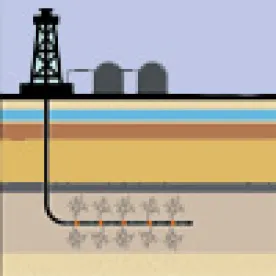The Bureau of Land Management contends that its new rules are consistent with state regulations and industry standards, but stakeholders believe that the rules are unnecessary or simply miss the mark.
On March 20, the Bureau of Land Management (BLM) released its long-awaited final rules (BLM Rules or the Rules) that regulate hydraulic fracturing on federal and tribal lands. The Rules establish requirements for a wide range of practices, such as well construction standards, management of flowback waters, and disclosure of fracturing fluids. Having deliberated for nearly three years and reviewed roughly 1.5 million comments, the BLM described the released Rules as “consistent with industry guidance [and] the voluntary practice of operators, and some are required by state regulations.”
Both the regulated community and environmental groups have disagreed. Industry groups have raised concerns that the Rules are unnecessary or otherwise burdensome and costly, whereas environmental groups complain that the Rules do not go far enough. Although the Rules are slated to take effect in three months, they may be delayed by litigation.
The BLM Rules
On May 11, 2012, the BLM published for public comment proposed rules that govern hydraulic fracturing practices on federal and tribal lands. In May 2013, the BLM responded to industry feedback by revising the proposed rules and allowing another round of public comment. Nearly two years later, the BLM released its final Rules, which cover the following:
-
Well construction—Well integrity is critical to withstanding the extreme temperatures and pressure beneath the surface and to prevent gas and fluids from escaping into the surrounding rock. Well construction standards must reduce risk of environmental harm within the constraints of operational realities. The BLM Rules include requirements relating to predrilling plans, environmental site reviews, casing and cementing standards, monitoring, testing, reporting, and plugging. Most state regulations also cover these categories, but, as always, the devil is in the details, as discussed below.
-
Flowback storage—All wells, whether hydraulically fractured or not, produce large volumes of salt water (i.e., “flowback”). The fluids are then stored in pits and/or tanks until they are reused or disposed of. Contrary to what they originally proposed, the BLM Rules prohibit storage in open-air pits and instead limit operators to above-ground tanks with a capacity of less than 500 barrels.
-
Disclosure of fracturing fluids—Wells are hydraulically fractured through the high-pressure injection of water with trace additives necessary to reduce friction, prop fractures open, and otherwise ensure safe and successful operation. Most states require operators to disclose the added constituents, subject to trade secret protections. Similarly, the BLM Rules require operators to submit disclosure reports to the FracFocus website within 30 days after completing well stimulation.
The BLM framed its Rules to be consistent with existing state regulations and industry practice, sufficient to ensure environmental protection, and not unduly burdensome or costly. However, as discussed below, few agree with its assessment.
Response to the BLM Rules
Well Construction Standards
Industry groups have criticized the proposed well construction standards as creating costs with no discernible environmental advantages. For example, the definition of “usable water” set forth in the Rules highlights this problem. As explained in our January 14, 2015 LawFlash, the proposed rules provided that, consistent with state rules and industry standards, operators would need to install casing at depths that protect usable water. The industry expressed concern that the proposed “usable water” definition of waters that contain up to 10,000 parts per million of total dissolved solids (ppm TDS), in fact, is generally considered to identify water that in reality has no potential use because treatment (e.g., reverse osmosis systems) would be too expensive. Also, waters that contain up to 10,000 ppm TDS generally cohabitate in formations with oil and gas resources; thus, casing installation would have to encounter the target zones, which makes development impractical. The industry argued that such measures were anticipated to come at significant cost and would discourage development on federal lands.
In its Rules, the BLM declined to modify the definition of “usable water.” It explained that, despite some apparent confusion, 10,000 ppm TDS has served as the US Environmental Protection Agency’s standard for usable water under the Safe Drinking Water Act for decades. As such, it concluded that the Rules would not require any operational changes or result in additional costs. Further, it rejected arguments that water containing 10,000 ppm TDS has no potential use and projected that future water scarcity and technological advancements may increase their utility. The BLM, thus, refused to change its definition of “usable water” in the Rules as requested by industry.
Management of Flowback Waters
Industry groups also oppose the above-ground tank storage requirement. In practice, flowback has been stored in pits (which are open to the air) or tanks (which are entirely closed off). Historically, only a few states have restricted the use of open pits. For example, Michigan has required that flowback be stored in tanks, and Mississippi has permitted open-air storage only if no other means are available. Recently, regulators have increasingly restricted the use of open-air pits to store flowback water. In late 2014, Illinois promulgated rules that limited flowback storage in open pits to no more than one week. And, earlier this month, the Pennsylvania Department of Environmental Protection confirmed its intentions to prohibit open pits and impose more stringent requirements for impoundments once its proposed rules are finalized, potentially in spring 2016.
Although the BLM’s proposed rules permitted storage in either tanks or lined pits, the BLM since has elected to prohibit the use of open-air pits, subject to demonstration that use of tanks “is infeasible for environmental, public health or safety reasons.” However, according to the BLM, “such exceptions should be limited and rarely granted.”
The BLM and environmental groups claim that all pits, regardless of construction, liners, or oversight, create too high a risk of releases into the environment. They posit that tanks, which are fully enclosed, minimize that risk. Tanks, however, are much more expensive. Under the BLM Rules, tank size will be limited to a capacity of 500 barrels (15,750 gallons). For reference, a single well can often generate hundreds of thousands of gallons of flowback, which would therefore require dozens of tanks. Accordingly, under the Rules, operators could expect to spend significantly more to store the same volume of fluids in tanks rather than in pits.
Disclosure of Fracturing Fluids
The BLM Rules’ fracturing fluid disclosure requirements generally received favorable industry reaction but criticism from environmental organizations. Industry groups described the Rules as representing a reasonable, convenient, and commonplace approach. By contrast, environmental groups have raised concerns about the trade secret protections included in the Rules. The disclosure requirements in the Rules are far from novel, as they are equivalent to those adopted in a majority of oil- and gas-producing states. Generally, the Rules call for disclosures to be made using FracFocus, an existing reporting and disclosure platform.
The BLM’s use of FracFocus is consistent with prevailing practices. FracFocus is not new. It first went online in April 2011 and has been used to register more than 94,000 wells across the United States. According to the FracFocus website, as of February 1, 2015, 22 of the 27 states that require chemical disclosure either use or are considering using FracFocus. It is a joint venture between the Groundwater Protection Council (which operates it) and the American Petroleum Institute and America’s Natural Gas Alliance (which fund it). Industry groups have stood behind it—for example, only months after the website was created, the Marcellus Shale Coalition required all of its members (effectively all operators active in the region) to submit reports to FracFocus.
The Rules’ protections for trade secret information are also not novel. Operators are entitled to trade secret protection in all states with chemical disclosure rules, and more general trade secret protection laws and regulations are standard throughout the country.
Environmental groups have criticized the Rules for failing to provide an adequate exception for disclosures to address medical emergencies. The groups argue that operators should be required to disclose trade secret information to medical personnel, particularly in the event of an emergency. State rules vary on this subject—some require disclosure to medical personnel and some do not; some limit disclosure to medical emergencies, while others extend it to general diagnosis and treatment. Notwithstanding these hydraulic fracturing–specific rules, federal Occupational Safety and Health Administration regulations generally require disclosure to medical personnel who treat on-site workers as may other state-specific exceptions.
Conclusion
Immediately after the Rules’ release, the Independent Petroleum Association of America and Western Energy Alliance jointly petitioned a federal court to review the Rules and invalidate them.[1] This challenge may also call into question whether the Rules will take effect in 90 days as planned if a stay of their implementation is also sought.
If and when the Rules do go into effect, operators should pay special attention to several unique and complicating considerations. First, the BLM Rules apply only to hydraulic fracturing operations on federal and tribal lands. As such, two wells in the same state may be subject to different rules to the extent that one is on public land and the other is on private property. Further, operations on federal and tribal lands will be subject not only to the BLM Rules, but also to the respective state’s operating requirements, including those that relate to permitting and notice, to the extent that they do not conflict with BLM regulations. Under some circumstances, a state may even enforce its rules, despite normally lacking jurisdiction on federal and tribal lands.
[1]. Independent Petroleum Association of America v. Jewell, Civ. No .15-cv-41-F (D.Wyo. March 20, 2015).



 />i
/>i

